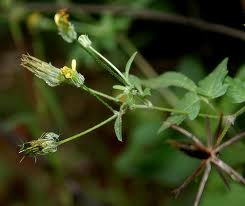| PlantID | 0063 | ||||||||||||||||||
| Botanical Name | Bidens biternata | ||||||||||||||||||
| Common Name | Kinehi | ||||||||||||||||||
| Classification |
| ||||||||||||||||||
| Part used | Whole plant, leaves, flowers roots and seeds. | ||||||||||||||||||
| Medicinal Properties | Seeds: anthelmintic. | ||||||||||||||||||
| Medicinal Use | Plant given in leprosy and skin diseases. Also useful in fistulae, pustules, tumours, phthisis, coughs, bites, stabs and other wounds. Infusion of leaf and root, a remedy for colic, juice of leaves applied to heal ulcers and to cure eye and ear problems. Rrubbed leaves are also used as a haemostatic on wounds, and wrapped around the umbilical cord of babies. Dried flower buds used in toothache. Flowers used in diarrohoia. Plant juice is used for eyesores. Seeds are used to cure anthelminthic problems in animals. | ||||||||||||||||||
| Chemistry | NA | ||||||||||||||||||
| Cultivation | NA | ||||||||||||||||||
| Regional Habitat | Commonly found in moist and shady places in the forests and gardens. Mature cypsels adhere to the clothes by awns, for dissemenation. Distribution: Jhunjhunu, Sawai Madhopur, Jaipur, Tonk, Bhilwara, Banswara, Jodhpur, Kota and Jhalawar districts. | ||||||||||||||||||
| Description | Erect, 15-20 cm high, glabrous herbs. Stem: tetragonous, sulcate. Leaves: petioles 0.3-0.4 cm long, lamina 2.5-7.9 cm, biternate, surfaces appressedly hairy; lateral segment sub-sessile/petiolule 0.1-0.4 cm long, attenuate at base, ovate, 0.9-4.7 x 0.6-3.3 cm, coarsely dentate or pinnatifid, apex acute; terminal segment petiolule 0.0-0.5 cm long, attenuate at base, elliptie, 1.9-5.3 x 0.8-2.5 cm, with 3-5 pinnatifid lobes on each side, apex acute/gradually acuminate. Flowers: capitula 0.3-1.0 cm across, numerous on divaricate branches, stalk 0.2-9.5 cm long; invol. bracts outer ones linear-oblanceolate, 0.4 x 0.05 cm, slightly accrescent, ciliate; inner ones ovate-lanceolate, 0.5 x 0.1 cm , glabrous; paleae linear-lanceolate, 1.0 cm long, 3-veined, accrescent; ray-florets usually 3, corolla ligulate, 2-3 dentate; disc-florets hermaphrodite, 0.7 cm long, pappus 0.2 cm long, corolla 0.5 cm long, tube 0.2 cm long, lobes acute, pubescent, anthers 0.2 cm long, style 0.5 cm long. Fruits: cypsels linear, 0.2-2.2 cm long, scabrid/glabrous, blackish. Flowers and fruits appears during August-November. | ||||||||||||||||||
| Image |  |
Bidens biternata

